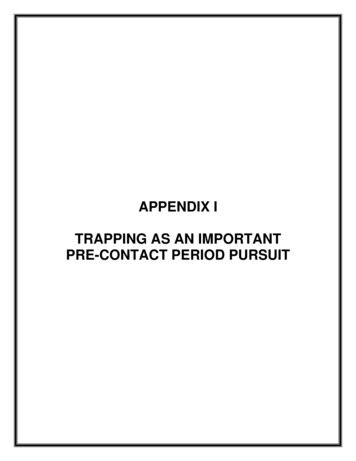
Transcription
APPENDIX ITRAPPING AS AN IMPORTANTPRE-CONTACT PERIOD PURSUIT
APPENDIX ITRAPPING AS AN IMPORTANTPRE-CONTACT PERIOD PURSUITByChristopher T. Espenshade
ABSTRACTTraditional trapping has been downplayed or outright ignored in archaeologicalreconstructions of pre-contact settlement and subsistence.In this appendix, the case ispresented that pre-contact trapping played a seasonally important role in pre-contactsubsistence, was an important factor in defining wintertime settlement patterns, and was anactivity that created literally millions of short-term, limited-activity sites.A circumstantial case is presented. It is shown that pre-contact inhabitants of Delawarehad the motive, the means, and the opportunity to trap a wide variety of species. The motive isshared with hunting: the need for meat, furs, bone, antler, and sinew.The means – effectivetraditional traps – is established from a review of seventeenth and eighteenth century accounts,from early twentieth century ethnographies conducted among eastern tribes, from oral historyamong Delaware’s surviving Native American communities, and from review of late nineteenthand twentieth century trapping guide books. It is shown that traditional snares and deadfallswere known to the eastern tribes, and that such traps are highly effective. Lastly, opportunity isdemonstrated by considering data on the modern and historic fur harvests. It is shown thatDelaware has an excellent furbearer biomass, and probably did throughout the pre-contactspan.Having argued that trapping was important to pre-contact inhabitants of Delaware, thearchaeological signatures of various trapping-related sites are defined. In addition, the impactof the recognition of trapping on regional models is discussed.
TABLE OF CONTENTSPageABSTRACTTABLE OF CONTENTS . I-iLIST OF FIGURES . I-iiLIST OF PHOTOGRAPHS . I-iiiLIST OF TABLES. I-iii1.0INTRODUCTION.I-12.0TYPES OF TRADITIONAL TRAPS .I-62.12.22.33.0Snares .I-6Deadfalls .I-19Pit Traps .I-30TARGETED SPECIES 143.153.163.17Muskrat.I-37Beaver .I-40Raccoon .I-41Opossum .I-42Rabbit .I-43Fox .I-44Bobcat .I-45Mink .I-45Spotted and Striped Skunks .I-45Fisher and Pine Marten .I-46Otter .I-47Bear.I-48Deer.I-49Groundhog .I-50Turkey .I-51Junco.I-51Incidental Captures .I-514.0THE TRAP LINE .I-535.0DEVELOPMENT OF MODERN TRAPPING .I-556.0EFFICIENCY OF TRAPPING .I-596.16.26.36.46.56.66.7The Problem of Efficiency .I-59Success of Modern Trapping in Delaware.I-59Judging Efficiency Relative to Steel Traps .I-61Direct Accounts of Efficiency of Traditional Traps .I-62Efficiency as Seen in the Humane Trapping Movement.I-63Efficiency Measured by Historic Productivity.I-64Summary of Efficiency Evidence .I-65I-i
TABLE OF CONTENTS(Continued)Page7.0TYPES OF TRAPPING SITES .I-667.17.27.37.47.57.67.7Anticipatory Trap Manufacture Locations .I-66On-Location Trap Setting .I-67Initial Prey Processing.I-68Initial Hide Processing.I-70Secondary Hide Processing .I-71Timely Meat Processing .I-75Summary .I-758.0SUMMARY OF PRE-CONTACT TRAPPING IN DELAWARE.I-779.0REFERENCES.I-809.19.2References Cited.I-80References Examined .I-89LIST OF FIGURESFigure No.TitlePageI-1Various Snares .I-7I-2Various Deadfalls.I-8I-3Seneca Snares .I-12I-4Cheswold Traps.I-13I-5Seneca Spring-Pole Snares .I-15I-6Nanticoke Snares .I-17I-7Iroquois Quail Snare .I-18I-8Seneca Deadfalls.I-23I-9Seneca Deadfalls.I-24I-10Seneca Deadfalls.I-25I-11Seneca Deadfalls and Snares .I-26I-12Leg-Hold and Conibear -Style Traps .I-56I-13Skinning/Drying Methods.I-72I-ii
LIST OF PHOTOGRAPHSPhotograph No.TitlePageI-1Ojibwa deadfall (from Irwin 1984b) .I-9I-2Innu deadfall (from Innu Nation 2005) .I-9I-3Skunk or woodchuck den, New Castle County, March 2005.Note obvious fresh dirt from den cleaning .I-10I-4Replica of a baited, spring-pole snare. .I-20I-5Replica of a spring-pole snare on a trail. Entanglement in snaretriggers spring-pole .I-21I-6Replica of a trip-stick deadfall.I-27I-7Replica of a figure-4 deadfall. .I-29I-8Delaware muskrat trapper, ca. 1930, with daily catch ofapproximately 20 muskrats (from DNREC 1993) .I-38I-9Delaware muskrat shed with stretched skins (left) and unskinnedmuskrats (right) (from DNREC n.d.) .I-38I-10Skinning a muskrat using stone tools .I-69I-11Ojibwa woman with stretched deer hide (from Irwin 1984b).I-74LIST OF TABLESTable No.TitlePageI-1Furbearer Remains at Mohawk Sites .I-33I-2Data on Species Trapped by Eastern Indian Groups .I-35I-3Summary of Fur Harvest in Delaware, 1995-2000 .I-60I-iii
1.0 INTRODUCTIONA general theme of the Site 7NC-B-54 (Ronald McDonald House) Phase III study is thatmany pre-contact activities are hard to recognize and predict, and that low-labor activitiesshould not be lumped into meaningless, generic labels such as “extractive stations” or “resourceprocurement locations.” In keeping with this theme, it is appropriate to consider in some detail aset of activities (animal trapping) and a range of site types rarely addressed in thearchaeological literature.The possibility that some of the loci at Site 7NC-B-54 were trapping-related came frominitial field impressions. The author of this appendix had trapped muskrats and opossum whilegrowing up in the North Carolina Piedmont. To him, the small wetlands in the site vicinity wouldhave attracted many furbearers, and therefore, may have attracted native trappers. Likewise,the low-density, short-term loci evidenced at the site might be consistent with trapping-relatedactivity. This overview is not intended to demonstrate that any locus of the site was definitelyrelated to trapping, but rather to suggest that archaeologists have generally downplayed theimportance of trapping and the frequency of trapping-related sites.An early study in Delaware offered the promise of recognizing key faunal and floralresources and then modeling settlement to address seasonal and spatial variability in thoseresources.Thomas et al. (1975:35) undertook “a comprehensive survey of environmentalresources in the Delaware coastal plain.” The researchers recognized the significant numbersof bear, deer, beaver, otter, muskrat, raccoon, and turkey in various Coastal Plain settings.However, they never specifically address trapping, instead subsuming such activity under thevague definition of hunting as “the procurement of large and small mammals, land fowl, waterfowl, and other animal foods.” Thomas et al. (1975:56) then develop models based on Indianstargeting the “most nutritious, most reliable, and most easily and efficiently procured” food items.Having no understanding of the efficiency of trapping, and having lumped trapping withgeneralized hunting, Thomas et al. (1975:56) surmise:The most easily procured foods are those that require the minimum input ofenergy for the total food acquisition. . . Hunted resources, generally, should bethe most difficult.In actuality, as argued below, traditional trapping is judged as considerably more efficient thanstalk hunting with a bow or atlatl, and in the right seasons and settings, trapping was probablyhighly reliable and easy. Because Thomas et al. (1975) were dismissive of hunting and ignoredI-1
trapping as a separate activity, none of their five subsistence-settlement models include furbearers other than deer. The detailed environmental reconstructions of Thomas et al. (1975)led subsequent researchers to build on their questionable models.In 1984, Jay Custer published Delaware Prehistoric Archaeology:Approach.An EcologicalIn 1995, Richard Dent published Chesapeake Prehistory: Old Traditions, NewDirections. Neither Custer nor Dent even mentions trapping as a Native American subsistenceactivity (although Custer does mention fish traps in passing and does address “fur hunting” inthe Contact period).Even after finding evidence of single-family, winter occupations at anumber of sites, Custer does not consider trapping as a possible explanation (Custer andHodny 1989; Custer et al. 1995; Custer and Watson et al. 1996; Custer and Riley et al. 1996).Custer also continues to label limited-visit sites as “staging/processing sites” (Custer andBachman 1984; Riley and Custer et al. 1994) or “hunting/processing camps” (Custer et al.1988). Taken literally, the two major researchers in our region would have us believe that theseIndians survived by hunting, gathering wild plants, shellfish collecting, fishing, and, in laterperiods, horticulture.Custer and Dent are not alone in their downplaying (or outright ignoring) the importanceof trapping in Delaware. In a series of Phase III reports, the following activities were posited: “While at the site they hunted game, probably white-tailed deer” (Hawthorn site:Custer and Bachman 1984:87). “a hunting/processing camp” (Dairy Queen site: Custer et al. 1988). “a small base camp or procurement staging site” (Hockessin Valley site: Custer andHodny 1989:i). “a micro-band base camp” (Lewden Green site: Custer et al. 1990:77). “short term transient camps” (Dover Downs site and 7K-C-360; Riley and Watson etal. 1994:i). “a staging/processing station” (Paradise Lane site; Riley and Custer et al. 1994). “most of the bifaces and unifaces were used in hunting and associated processingtasks” (Two Guys site: LeeDecker et al. 1996:86). “a Woodland II procurement site” (Drawer Creek site: Wall et al. 1997:110). a series of single-family wintertime houses (Pollack Prehistoric site; Custer et al.1997).I-2
“a procurement and processing station for game and plant resources” (WhitbyBranch site; Jacoby et al. 1997). “the processing of nuts was probably a major focus of activity” (Lum’s Pond site;Petraglia et al. 1998:183). “a fishing camp” and “a campsite used for brief stays, possibly because it waslocated on a trail, near a canoe landing, or near an extinct spring” (Puncheon Runsite; LeeDecker et al. 2001:i)In fact, a review of 20 Phase II or Phase III reports from Delaware failed to find a single mentionof trapping as a possible activity (however, Heite and Blume [1998] mention trapping as aseasonal activity at a possible late eighteenth-early nineteeth century Indian community).Instead, hunting, fishing, nut-gathering, or general procurement are suggested. When in doubt,the presence of projectile points is apparently considered enough to kick the sites into thehunting camp category. Even for limited-use sites overlooking some of the most productivemuskrat marshes in the eastern United States, no mention is made of trapping. Even whensingle-family, wintertime households are posited, trapping is not mentioned as a likelysubsistence activity.It is not argued here that all pre-contact sites, or even a majority of pre-contact sites inDelaware were trapping-related, but there were undoubtedly thousands of trapping-relatedlocations used in pre-contact times.It would provide a fuller picture of pre-contact life ifarchaeologists would at least consider the possibility that trapping-related activities occurred ata site under study.Trapping is a labor-efficient means of increasing encounters between animals and theirhuman stalkers (Goodchild 1984). Unlike hunting, which requires a human presence during thekill, trapping can capture animals at any time, especially when humans are gone. To viewtrapping in human terms, imagine that each trap set was actually a family member left to guarda location. Only with a very large, extended family (of people with excellent night vision, perfectaim with a bow or atlatl, no scent, and no need to sleep) could the many animal burrows andtrails be covered full-time. A trap stays functional (until tripped) for the entire time it is set. Witha few notable exceptions (e.g., the Inuit who guards a seal’s breathing hole for hours on end),the return from hunting does not justify investment of hours and hours of labor on a singlelocation. In addition, most of the furbearers of the eastern United States are nocturnal, therebyreducing the chance for human-prey encounters; a trap works all night. The capture and killingof game demands encounters; trapping significantly increases the opportunities for encounter.McPherson and McPherson (1994:152, emphasis in original) summarize:I-3
One thing that about all outdoorsmen/woodsmen/survivalists will agree on is thefact that the trap line is the MOST expedient method of keeping a supply of meaton hand with a minimum of effort.Holliday (1998) sampled the global ethnographic record to determine the ecologicalsettings in which trapping played the greatest role. He found that trapping was most importantto groups in the Boreal/Northern Deciduous Forest setting, his category that most closelymatched Woodland I conditions in Delaware. For the warmer ranges of this zone (that portionbest mimicking Woodland I period Delaware), Holliday (1998:717) surmises that “the mixedhunting/fishing/trapping strategy” was most commonly adopted. Holliday (1998:715) also notesthat trapping intensity increases as groups move from nomadic to semi-sedentary to sedentary.With this view of trapping (and the efficiency of trapping will be discussed in greaterdetail below), it is baffling that trapping is so often slighted in the archaeological literature. Theimportance of trapping no doubt varied culture to culture, family to family, and season toseason. However, it is hard to imagine any group that would not have taken advantage of anefficient means to capture meat and fur.The downplaying of trapping in native Delaware is even more difficult to understandgiven the reputation of the Nanticoke. Heckewelder (1971:92) reports of the Nanticoke:The Mohicans, for instance, call them Otayáchgo, and the DelawaresTawachguáno, both of which words in their respective languages, signify a“bridge,” a “dry passage over a stream;” which alludes to their being noted forfelling great numbers of trees across streams, to set their traps on. They arealso often called the Trappers.Likewise, Morgan (1962:93) reports that among the Iroquois “trapping game of all kinds,from bear and deer to the quail and snipe, was a common practice.”In this appendix, pre-contact trapping in the Northeast will be discussed through aconsideration of ethnographic data. There is a certain risk in pushing back Contact periodbehavior into prehistory, but we know enough of European trapping methods to recognizeintroduced behaviors and technologies. Lacking the surviving artifacts of pre-contact trapping orpre-contact depictions of trapping (but see Shaffer et al. 1996 for a discussion of trappingbehavior illustrated on Mimbres pottery bowls from the southwestern United States), we mustassume that Contact period technologies were also in use in the pre-contact period.After considering the ethnographic data, information on historic to modern trappingbehavior is presented, information which was gained through interviewing members of the localI-4
Native American communities and modern Euro-American trappers. Given the unevenness ofthe written ethnographic coverage of local groups, oral history of remnant groups is important. Itwas also considered important to address changes in the distributions of furbearers relative tomodern land use.The data on historic and modern trapping participation and yield will be considered toaddress questions of the efficiency of trapping and the potential of the furbearing biota ofDelaware. These data suggest that trapping in pre-contact periods had the potential to providea significant portion of the meat diet, as well as culturally important furs. In addition, the spatialdistributions of the major furbearers are discussed, especially as those distributions may haveaffected pre-contact settlement strategies.The last part of this appendix is a consideration of the archaeological site types thatshould be expected as a result of pre-contact trapping.The author agrees with Holliday(1998:711) that “the problem with identifying trapping in the archaeological record, however, isthat only rarely are the raw materials from which traps are made preserved.” A major goal ofthe definition of trapping site signatures is to broaden the perspective of archaeologists. Forexample, the recovery of hafted knives/projectile points and hide-scraping tools does notnecessarily mark the location of a successful hunt.I-5
2.0 TYPES OF TRADITIONAL TRAPSThis discussion of native trapping was informed by ethnohistoric and ethnographicaccounts (Cooper 1938; Feest 1978; Fenton 1978; Speck 1915, 1946a; Speck et al. 1946;Weslager 1943), as well as interviews with the Nanticoke Indians of Oak Orchard, Delaware, theLeni Lenape Indians of central Delaware and southern New Jersey, and modern trappers. Thethree basic forms of traditional traps were snares, deadfalls, and pit traps. Steel, leg-hold trapswere not used by Indians in the region until late in the eighteenth century (Cooper 1938:12).A snare is a cordage or (post-contact) wire loop that is placed across an animal path, ata bait, or in a den entrance, and that tightens on the animal’s throat or mid-section (Figure I-1).Certain snares are intended to simply hold the animal, while others are designed to choke theprey or break its neck.The second class of traps is deadfalls, which rely on falling objects to kill or immobilizethe prey (Figure I-2; Photographs I-1 and I-2). Deadfalls can be baited or simply set on animaltravel routes.With the last class of traps, pit traps, animals are lured or stumble into excavated pitsfrom which they cannot escape. The animals are often still alive after capture in a pit trap.Regardless of the type of trap, the device must be placed where the prey lives or travels.The most obvious location is often the den; Photograph I-3 shows an easily recognized skunk orwoodchuck den after “Spring cleaning.” Although baits can attract prey from some distance, thebest success comes from locating or creating a travel corridor for the prey. This can be done byconstructing artificial constrictions in existing trails or by establishing a new, convenient travelroute. The Nanticoke tradition of felling logs across streams (Feest 1978:244) is characteristicof the latter alternative. Animals will use fallen trees to cross streams, and such trees bring preyto a well-defined location. Furbearers may avoid a freshly chopped tree, but are likely to beusing a Spring-chopped tree by the following Fall.2.1SnaresSnares were recorded in the Nanticoke community of Indian River Hundred (Speck1915) and at the Cheswold Leni Lenape community (Weslager 1943). Two types of snareswere used by the Rappahannock to capture rabbit, raccoon, opossum, mink, “and the like”(Speck et al. 1946). Cooper (1938:131) reports that the Seneca used snares for deer, mink,I-6
SOURCE: HARDING 1951DELAWARE DEPARTMENT OF TRANSPORTATIONBLUE BALL AREA TRANSPORTATION IMPROVEMENTSPHASE IIIRONALD MCDONALD HOUSE SITE (7NC-B-54)BRANDYWINE HUNDREDNEW CASTLE COUNTYVARIOUS SNARESFIGURE I-1SKELLY and LOY Inc.CONSULTANTS INENVIRONMENT - ENERGYENGINEERING - PLANNING
SOURCE: HARDING 1951DELAWARE DEPARTMENT OF TRANSPORTATIONBLUE BALL AREA TRANSPORTATION IMPROVEMENTSPHASE IIIRONALD MCDONALD HOUSE SITE (7NC-B-54)BRANDYWINE HUNDREDNEW CASTLE COUNTYVARIOUS DEADFALLSFIGURE I-2SKELLY and LOY Inc.CONSULTANTS INENVIRONMENT - ENERGYENGINEERING - PLANNING
Photograph I-1. Ojibwa deadfall (from Irwin 1984b).Photograph I-2. Innu deadfall (from Innu Nation 2005).I-9
Photograph I-3. Skunk or woodchuck den, New Castle County, March 2005.Note obvious fresh dirt from den cleaning.I-10
rabbit, skunk, groundhog, and grouse (Figure I-3). The twitch-up snare was also used for turkeyamong the northern Iroquois (Fenton 1978:298). Among the northern Algonquian and northernAthapaskan, Cooper (1938:9) reports:More commonly snares are set for grouse (ruffed grouse and ptarmigan, notCanada grouse), rabbit, fox, lynx, caribou, moose, and bear; sometimes, too,skunk and ground-hog. Snares are not used, so far as I have ever seen orheard, for fisher, marten, mink, weasel, muskrat, beaver, and otter.Morgan (1851:93) reports the Iroquois use of spring-pole snares for deer. Deer snareswere also used among the Indians of southern New England (Day 1978:154), and Feest(1978:244) reports that “spring-pole snares for catching deer are reported from Kickotank inMaryland.” Of the Catawba, Speck (1946a:16) reports “the choke snare was formerly set fordeer.” Cooper (1938:131) described the Seneca deer snare:The snare line used was of hemp, not of basswood fiber, the noose itself beingabout 2 ½’ in diameter. The snare was set up between two standing trees; thesnare line was tied securely to one of these trees, while the noose was attachedlightly to a limb on the other tree. It was so attached merely in order to keep thenoose in rounded shape, not for the purpose of helping to hold the snaredanimal. The deer was snared by the neck, not by the feet. No spring pole wasused.Harding (1951), in a modern trapping manual, suggests snares are suitable for rabbit,skunk, fox, bear, opossum, lynx, and bobcat. Harding (1951:31) specifically notes “to catch askunk in a snare is almost as easy and as reliable a way as to take the animal in a steel trap,while it also does away almost entirely with the scent nuisance.”A static snare, such as the deer snare described above, was also known among theIndians of Delaware. Weslager (1943:181) illustrates a static snare that he attributes to theCheswold community (Figure I-4). Weslager (1943:182) offers a description of the static snare:A third trapping device for catching game is locally known as a “snoose” or“snooge.” Its name is a result of combining snare and noose. It consists of a slipnoose arranged in the animal track and concealed by brush. The loose end ofthe noose is fastened securely to a tree or fence post. The unsuspecting rabbitenters the noose, which is larger than his head but not large enough for his body.As he tugs to escape, the noose tightens and he cannot free himself. The morehe struggles, the tighter the noose is drawn around his body, and the endanchored to the tree prevents his running away.I-11
SOURCE: COOPER 1938DELAWARE DEPARTMENT OF TRANSPORTATIONBLUE BALL AREA TRANSPORTATION IMPROVEMENTSPHASE IIIRONALD MCDONALD HOUSE SITE (7NC-B-54)BRANDYWINE HUNDREDNEW CASTLE COUNTYSENECA SNARESFIGURE I-3SKELLY and LOY Inc.CONSULTANTS INENVIRONMENT - ENERGYENGINEERING - PLANNING
SOURCE: WESLAGER 1943:181DELAWARE DEPARTMENT OF TRANSPORTATIONBLUE BALL AREA TRANSPORTATION IMPROVEMENTSPHASE IIIRONALD MCDONALD HOUSE SITE (7NC-B-54)BRANDYWINE HUNDREDNEW CASTLE COUNTYCHESWOLD TRAPSFIGURE I-4SKELLY and LOY Inc.CONSULTANTS INENVIRONMENT - ENERGYENGINEERING - PLANNING
There were various versions of spring-pole snares used in the eastern United States(see Figure I-4; Figure I-5). All use a green pole or living tree to lift the ensnared animal off theground, thereby tightening the snare and lessening the ability of the animal to escape. A springpole snare can use a notched wood trigger or a string-and-toggle trigger. Both types of triggersrely on the initial jerk of the animal being snared or the jerk of the prey grabbing the bait torelease the trigger, allowing the bent pole or sapling to straighten. A properly constructedspring-pole snare can prevent escape by chewing. Cooper (1938:132) describes the capture:The animal, when entering or leaving the den or burrow, puts his head andforepaws through the noose, and so drags the snare line until the spring pole isreleased. He is then hoisted up by the noose around his body between the foreand hind legs, and hangs head down, about 6' to 8' above ground level.There have been very few studies of trap efficiency, but one modern European study comparedthe capture rate of static and spring-pole snares for alpine marmots, distant relatives of theAmerican groundhog
and twentieth century trapping guide books. It is shown that traditional snares and deadfalls were known to the eastern tribes, and that such traps are highly effective. Lastly, opportunity is demonstrated by considering data










